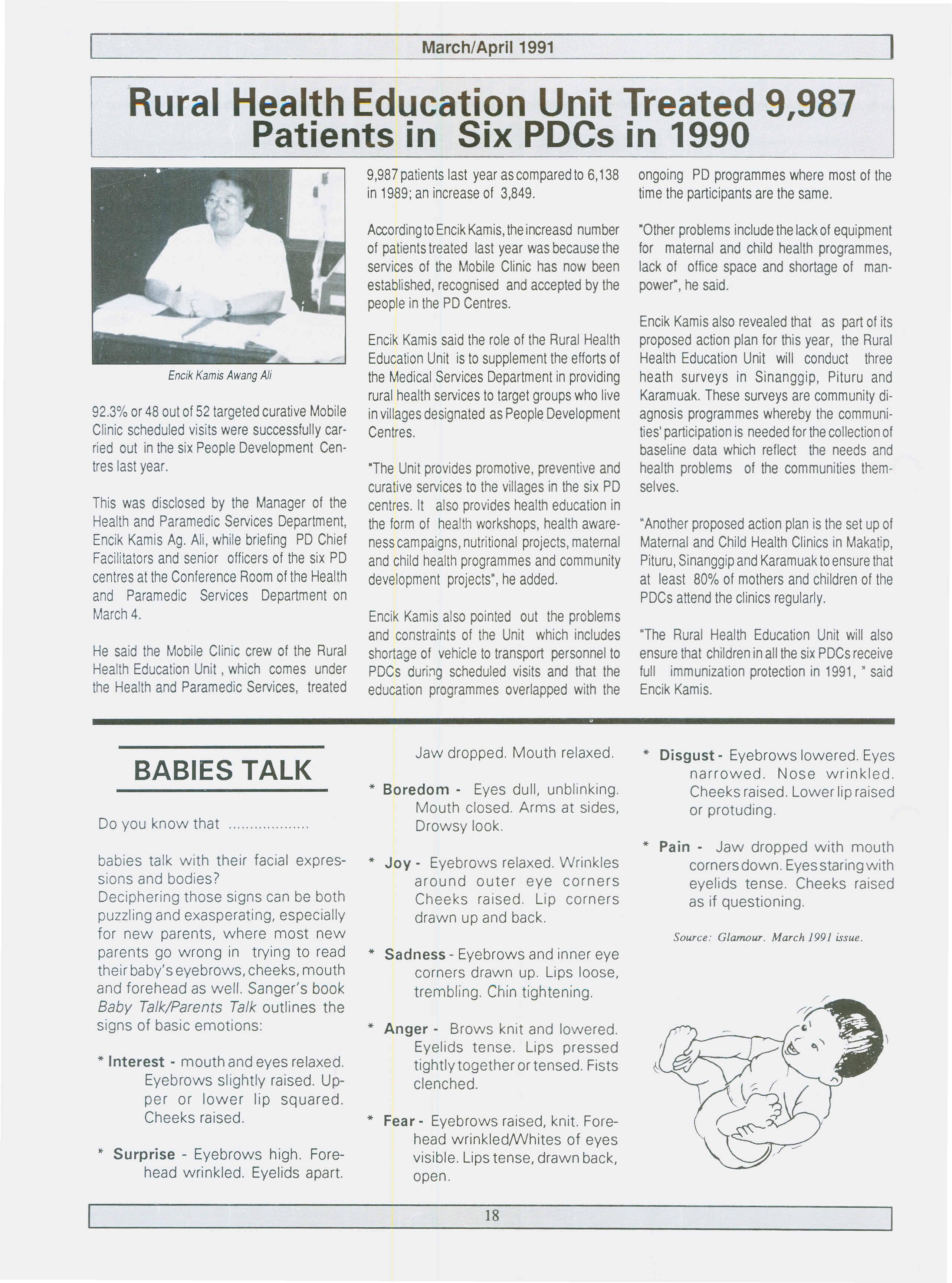
3 minute read
Rural Health Education Unit Treated 9,987 Patients in Six PDCs
'Rural Health Education Unit Treated 9,987 Patients in Six PDCs in 1990
9,987 patients last year as compared to 6,138 in 1989; an increase of 3,849. ongoing PO programmes where most of the time the participants are the same.
92.3% or 48 out of 52 targeted curative Mobile Clinic scheduled visits were successfully carried out in the six People Development Centres last year.
This was disclosed by the Manager of the Health and Paramedic Services Department, Encik Kamis Ag. Ali, while briefing PO Chief Facilitators and senior officers of the six PO centres at the Conference Room of the Health and Paramedic Services Department on March 4.
He said the Mobile Clinic crew of the Rural Health Education Unit, which comes under the Health and Paramedic Services, treated According to Encik Kamis, the increasd number of patients treated last year was because the services of the Mobile Clinic has now been established, recognised and accepted by the people in the PO Centres.
Encik Kamis said the role of the Rural Health Education Unit is to supplement the efforts of the Medical Services Department in providing rural health services to target groups who live in villages designated as People Development Centres.
'The Unit provides promotive, preventive and curative services to the villages in the six PO centres. It also provides health education in the form of health workshops, health awareness campaigns, nutritional projects, maternal and child health programmes and community development projects", he added.
Encik Kamis also pointed out the problems and constraints of the Unit which includes shortage of vehicle to transport personnel to PDCs duri;lg scheduled visits and that the education programmes overlapped with the 'Other problems include the lack of equipment for maternal and child health programmes, lack of office space and shortage of manpower', he said.
Encik Kamis also revealed that as part of its proposed action plan for this year, the Rural Health Education Unit will conduct three heath surveys in Sinanggip, Pituru and Karamuak. These surveys are community diagnosis programmes whereby the communities' participation is needed for the collection of baseline data which reflect the needs and health problems of the communities themselves.
"Another proposed action plan is the set up of Maternal and Child Health Clinics in Makatip, Pituru, Sinanggip and Karamuak to ensure that at least 80% of mothers and children of the PDCs attend the clinics regularly.
"The Rural Health Education Unit will also ensure that children in all the six PDCs receive full immunization protection in 1991, ' said Encik Kamis.
babies talk with their facial expressions and bodies? Deciphering those signs can be both puzzling and exasperating, especially for new parents, where most new parents go wrong in trying to read their baby's eyebrows, cheeks, mouth and forehead as well. Sanger's book Baby Talk/Parents Talk outlines the signs of basic emotions:
* Interest· mouth and eyes relaxed. Eyebrows slightly raised. Upper or lower lip squared. Cheeks raised.
• Surprise - Eyebrows head wrinkled.
high. ForeEyelids apart. * Boredom - Eyes dull, unblinking. Mouth closed. Arms at sides, Drowsy look.
* Joy - Eyebrows relaxed. Wrinkles around outer eye corners Cheeks raised. Lip corners drawn up and back.
* Sadness - Eyebrows and inner eye corners drawn up. Lips loose, trembling. Chin tightening.
* Anger - Brows knit and lowered. Eyelids tense. Lips pressed tightly together or tensed. Fists clenched.
* Fear - Eyebrows raised, knit. Forehead wrinkledMlhites of eyes visible. Lips tense, drawn back, open. * Disgust - Eyebrows lowered. Eyes narrowed. Nose wrinkled. Cheeks raised. Lower lip raised or protuding.
* Pain· Jaw dropped with mouth corners down. Eyes staring with eyelids tense. Cheeks raised as if questioning.








